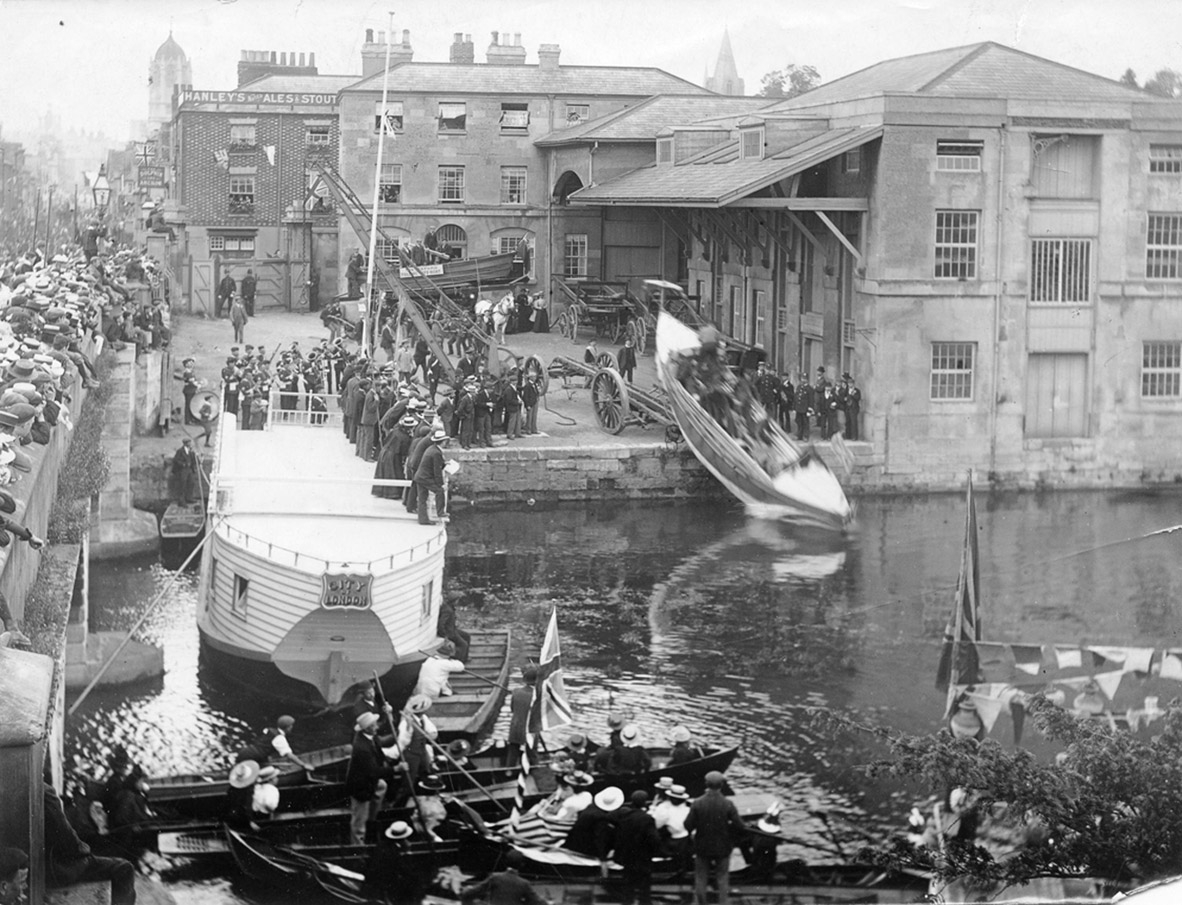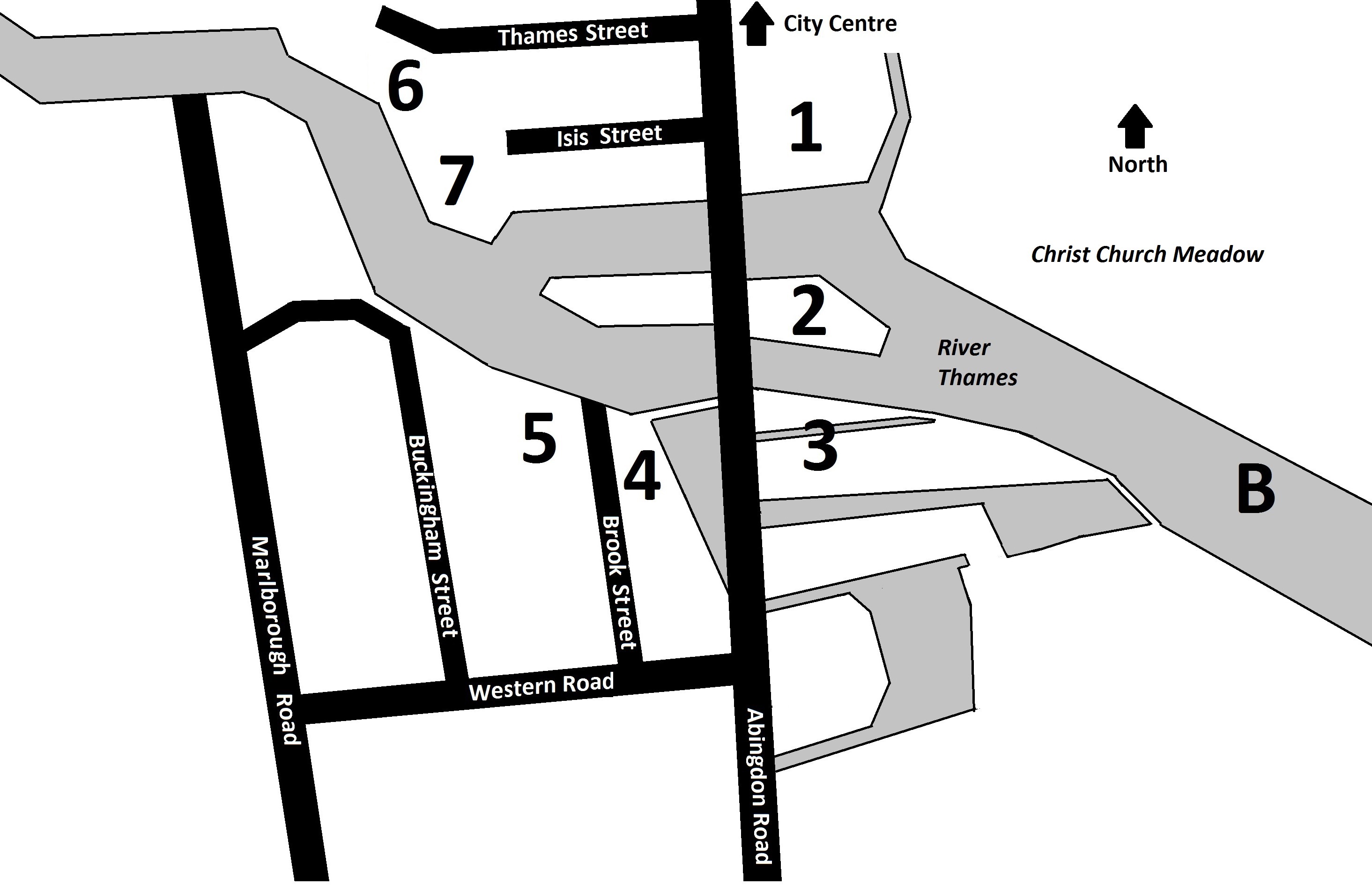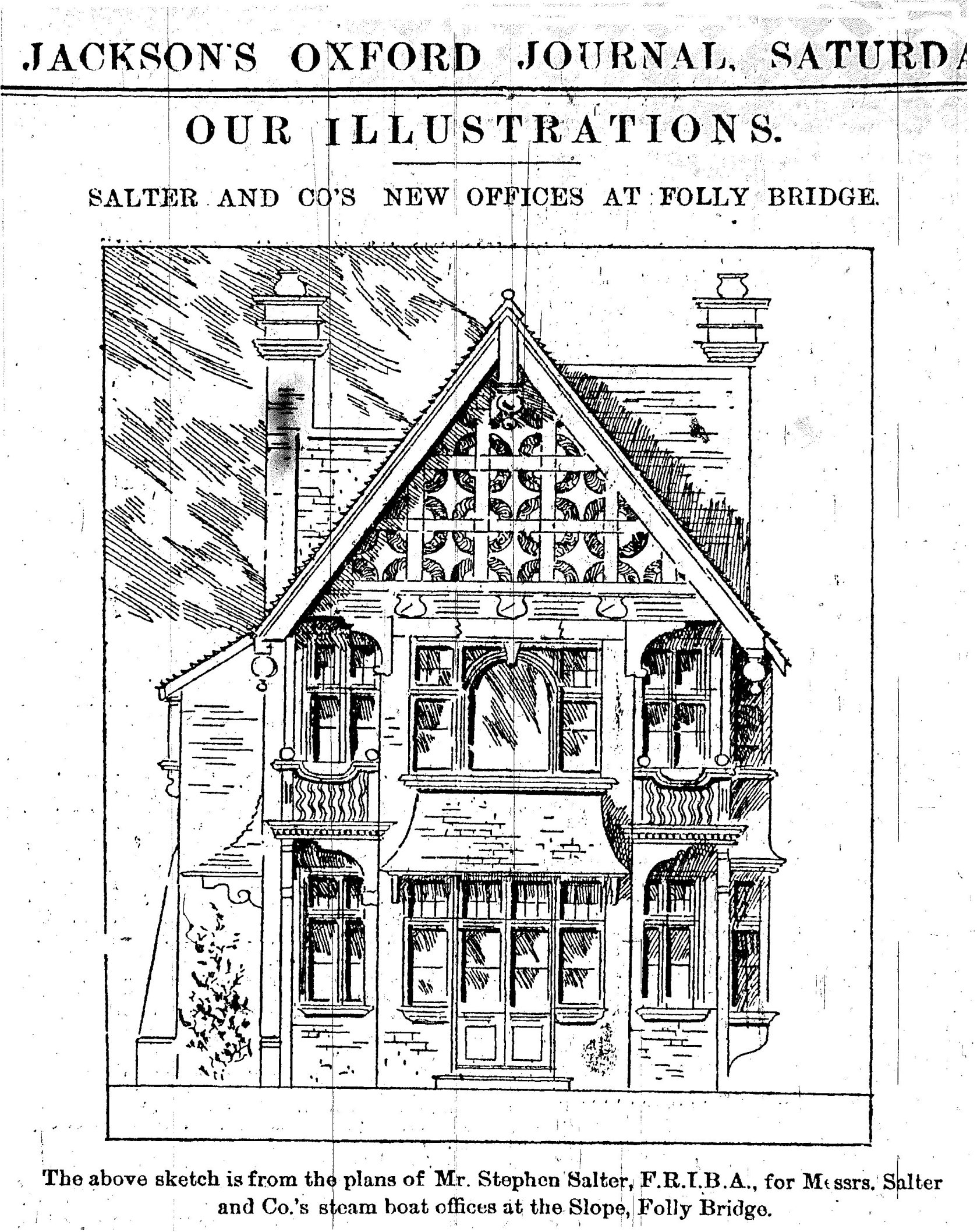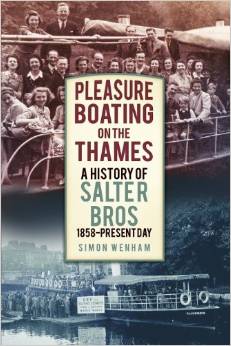
Crowds at Folly Bridge watch the dramatic launch of a lifeboat from Salter's boatyard, 1900. The winch visible near the centre of this photograph still exists, in what is now the Head of the River's courtyard garden. Image © Oxfordshire County Council, Oxfordshire History Centre, ref: D254071a.
Salter's Steamers was founded by brothers John and Stephen Salter who had had a boat-building business in Wandsworth since the mid 1830s. When they came to Oxford in 1858 they took over Isaac King's boatyard at the northern end of Folly Bridge. The 'St Aldate's Yard' as it was called comprised a wharf house and warehouse (now the Head of the River pub), stables, a dwelling house, a crane and the adjacent wharf. The buildings can be seen in this photograph and on this plan of 1844. The wharf house and warehouse were built in 1827 when the new Folly Bridge was built, but the wharf is much older, and dates back to at least 1638.

Salter's sites at Folly Bridge. A block of flats (the 'Red Flats') replaced a former boat-building and repair workshop (the 'Red Shops') on the site marked no. 4. The workshop marked no. 5 was converted into flats in 2000 and the block is named Jean Marguerite Court after the grandmother of the current owner of the company. A winch which hangs over the towpath nearby was retained in the development. To the south Arthur Salter Court, named after the current owner's grandfather, was built in 2005 on the site of yet another workshop. Diagram courtesy of Dr Simon Wenham.
Gradually Salter's took over other buildings nearby, and erected new ones, and by 1887 they occupied not only the St Aldate's Yard (no. 1 on this diagram), but also Folly Island (no. 2), Grandpont Yard (no. 3, where Hertford College accommodation is now) and the adjacent white warehouse (now Salter's main office) which was built in 1835-6 by a previous boat-building firm, Carter, Sherratt & Hall. Salter's had several workshops at the northern end of Brook Street (nos. 4 and 5) and another a mile downstream (which they still occupy), near what is now Donnington Bridge, next to the City of Oxford Rowing Club. There were Salter's yards at the end of Thames Street (no. 6) and Isis Street (no. 7 - this street no longer exists).
![Salters boatbuilders foreman Baker c1905 [Salters boatbuilders foreman Baker c1905]](/images/photos/Local_history_section/Salters/Salters_boatbuilders_foreman_Baker_c1905.jpg)
Foreman boat builder Thomas Arnold Baker (front left) at Salter's workshops on Buckingham Street, c. 1905. The best Salter's boats were those that were 'Baker-built'. Image copyright Salter's Steamers Ltd.
Salter's built all manner of boats - rowing boats, racing craft, canoes, college barges, pleasure boats, house boats, steam launches, paddle steamers, military boats and lifeboats. These they sold throughout the UK and abroad. At one time they were manufacturing up to 350 boats a year at Folly Bridge, and the company grew to become one of foremost inland boat builders in Britain, with a world-wide reputation. In the 1860s Salter's were the country's leading racing boat builder. They still have more record-breaking times in the Oxford-Cambridge boat race than any other boat builder.
![Salters at Folly Bridge with GWR notice Simon Wenham Dec 13 [Salters at Folly Bridge with GWR notice Simon Wenham Dec 13]](/images/photos/Local_history_section/Salters/Salters_at_Folly_Bridge_with_GWR_notice_Simon_Wenham_Dec_13.jpg)
Passengers boarding the steamer Cliveden at Folly Bridge in the 1930s. The board advertises 'GWR and Salters Steamers tour of Oxford and Morris Works' [the Cowley car works]. During the Second World War Cliveden and another Salter's passenger boat, Mapledurham, were requisitioned by the admiralty and used as hospital ships during the London Blitz. Image copyright Salter's Steamers Ltd.
Salter's also became one of the largest riverboat operators in the country, having started to run passenger boats from Oxford to Kingston in 1888. This route became incredibly popular and Salter's played a major role in the commercialisation of leisure on the Thames. In partnership with the Great Western Railway they offered round trips whereby the journey to the downstream destination was by boat, the return by train. They also went into private boat hire, and played an important role in popularising camping as a recreational pastime, as people would hire a Salter's rowing boat and go on a river trip lasting several days, camping overnight on the bank. Private boat hire is now Salter's main business.

Salter's employed a large number of people locally, who were known as the 'Salter's Navy'. Four concrete houses on the western side of Buckingham Street (with their render scored to look like stone) are some of the sixty or so properties which Salter's built to rent out to their workers and others. All the houses on the eastern side of Buckingham Street were originally Salter's.
The second generation of the Salter family were prominent Methodists and tee-totallers, and as business boomed the family rose in status. Within a century it produced two mayors of Oxford, an MP for the University, a Waterman to the Queen and an architect, Stephen Salter. In 1900 he designed the delightfully quirky offices, club room and passenger waiting room on Folly Bridge Island which replaced the by-then derelict Boathouse Tavern. There is a photograph of the offices taken in 1911 here.
Stephen Salter was also responsible for several other somewhat eccentric buildings in Oxford, including Lloyd's Bank at Carfax and the Cowley Road Methodist Church, on the corner of Jeune Street, as well as houses within and outside the city.

- For lots more information on Salter's see Dr Simon Wenham's book Pleasure Boating on the Thames: A History of Salter Bros, 1858-Present Day (The History Press, 2014). Copies are available at the Salter's offices on Folly Bridge.
- For a guided walk around this area see Malcolm Graham, On Foot from the High to Trill Mill (Oxford Preservation Trust, 2020), pp.89-96.
Plan of Folly Bridge and its surroundings drawn up in July 1844, shortly after the opening of the nearby Great Western Railway station, when nearby wharves were for sale by auction. St Aldates Yard (Lot 1) was later owned by Salter's. The key to the buildings is lower down. Image © the Bodleian Library, ref: Bodl GA fol B 71, 132. (Click image to close)
![Auction of wharfs, Folly Bridge, 1844, Bodl GA fol B 71, 132, map [Auction of wharfs, Folly Bridge, 1844, Bodl GA fol B 71, 132, map]](/images/photos/Local_history_section/Folly_Bridge/Auction_of_wharfs_Folly_Bridge_1844_Bodl_GA_fol_B_71_132_map.JPG)
![Folly Bridge Island, Salter's offices [Folly Bridge Island, Salter's offices]](/images/photos/Local_history_section/Folly_Bridge/Folly Island Salters offices HT11375.jpg)
![Folly Bridge Island, Salter's offices [Folly Bridge Island, Salter's offices]](/images/photos/Local_history_section/Folly_Bridge/Salters_workshops_Brook_Street_Carole_Newbigging_date_unknown_smaller.jpg)